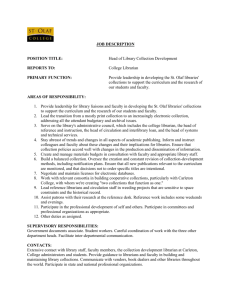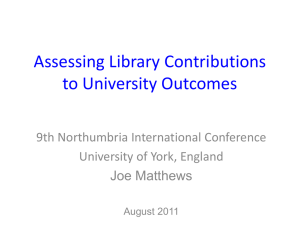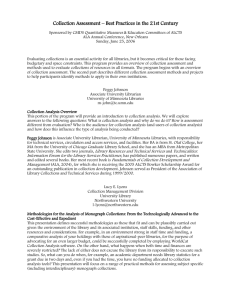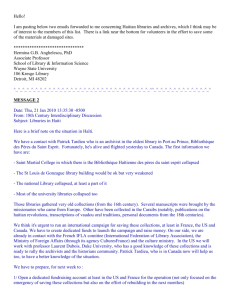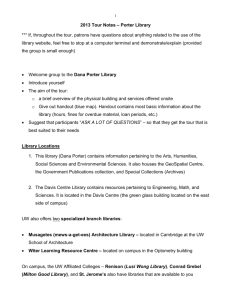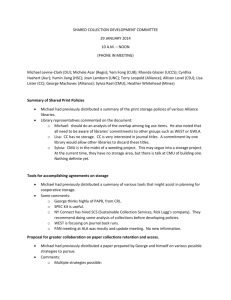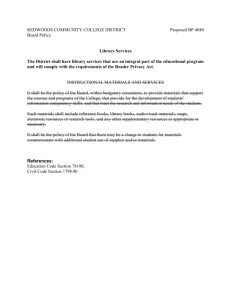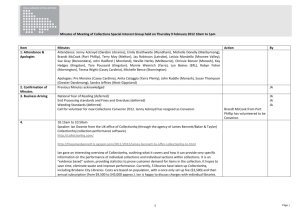FAQ - Orbis Cascade Alliance
advertisement
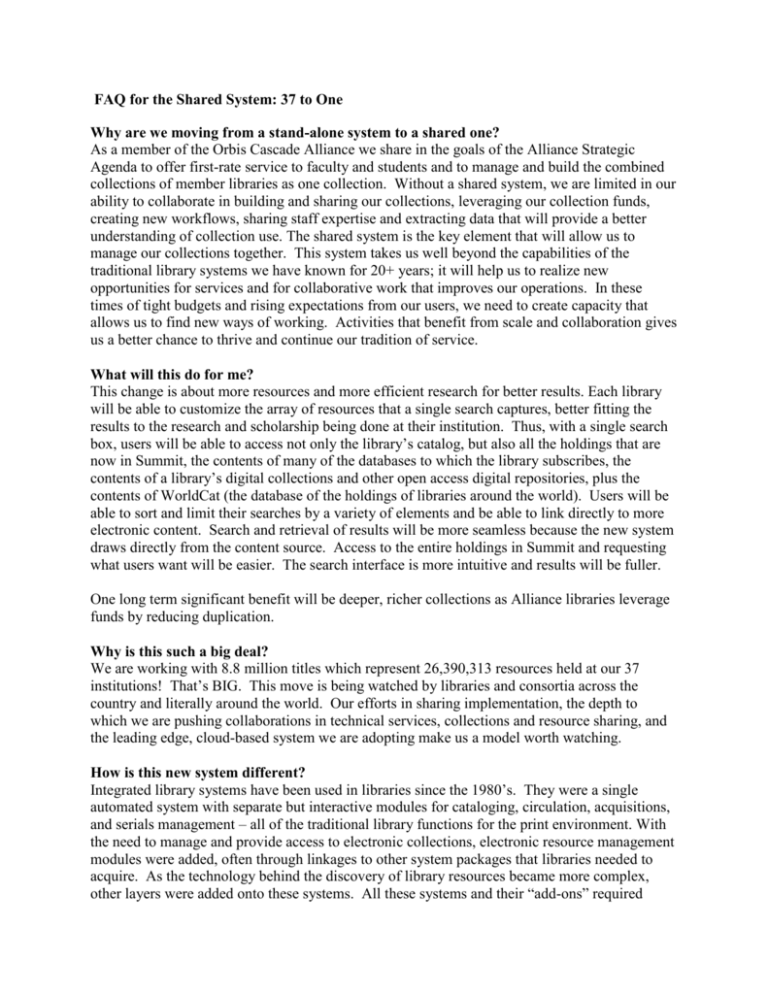
FAQ for the Shared System: 37 to One Why are we moving from a stand-alone system to a shared one? As a member of the Orbis Cascade Alliance we share in the goals of the Alliance Strategic Agenda to offer first-rate service to faculty and students and to manage and build the combined collections of member libraries as one collection. Without a shared system, we are limited in our ability to collaborate in building and sharing our collections, leveraging our collection funds, creating new workflows, sharing staff expertise and extracting data that will provide a better understanding of collection use. The shared system is the key element that will allow us to manage our collections together. This system takes us well beyond the capabilities of the traditional library systems we have known for 20+ years; it will help us to realize new opportunities for services and for collaborative work that improves our operations. In these times of tight budgets and rising expectations from our users, we need to create capacity that allows us to find new ways of working. Activities that benefit from scale and collaboration gives us a better chance to thrive and continue our tradition of service. What will this do for me? This change is about more resources and more efficient research for better results. Each library will be able to customize the array of resources that a single search captures, better fitting the results to the research and scholarship being done at their institution. Thus, with a single search box, users will be able to access not only the library’s catalog, but also all the holdings that are now in Summit, the contents of many of the databases to which the library subscribes, the contents of a library’s digital collections and other open access digital repositories, plus the contents of WorldCat (the database of the holdings of libraries around the world). Users will be able to sort and limit their searches by a variety of elements and be able to link directly to more electronic content. Search and retrieval of results will be more seamless because the new system draws directly from the content source. Access to the entire holdings in Summit and requesting what users want will be easier. The search interface is more intuitive and results will be fuller. One long term significant benefit will be deeper, richer collections as Alliance libraries leverage funds by reducing duplication. Why is this such a big deal? We are working with 8.8 million titles which represent 26,390,313 resources held at our 37 institutions! That’s BIG. This move is being watched by libraries and consortia across the country and literally around the world. Our efforts in sharing implementation, the depth to which we are pushing collaborations in technical services, collections and resource sharing, and the leading edge, cloud-based system we are adopting make us a model worth watching. How is this new system different? Integrated library systems have been used in libraries since the 1980’s. They were a single automated system with separate but interactive modules for cataloging, circulation, acquisitions, and serials management – all of the traditional library functions for the print environment. With the need to manage and provide access to electronic collections, electronic resource management modules were added, often through linkages to other system packages that libraries needed to acquire. As the technology behind the discovery of library resources became more complex, other layers were added onto these systems. All these systems and their “add-ons” required considerable behind the scenes work and maintenance to make all the pieces interact. These systems were great for their time but now these old systems make it difficult and costly to create new services, integrate other functions, create new workflows, and extract data. For example, it is essentially impossible for Alliance libraries to meaningfully pair up circulation and collections data in a way that allows for informed cooperative collection development. This new system will operate in a cloud computing environment, with the various pieces needed to manage 21st century library operations developed interconnectedly. Because it is managed “in the cloud,” libraries will no longer need to maintain servers and manage the system as we currently do. Services that libraries purchased separately, for example proxy servers, link resolvers, discovery layers, serials management, and authority control, are now all part of this new system. The architecture is designed to better incorporate, manage, discover and access electronic resources. Those digital collections Alliance libraries are creating will be discoverable through this new system as well, as will the contents of many of the databases we purchase. Resource sharing among our institutions is critical, as is a “next generation” public interface that allows library users to discover and access the complex universe of available resources. Having one system will improve the research experience for our users and allow staff to create value added services. How is the cost shared? The Alliance is funded solely by its member libraries. With the move from 37 systems to one, system costs will be shared among all members according to a 60/40 formula. The 40% is a flat rate which each member contributes; the 60% is a calculation based on an institution’s student FTE. This formula recognizes the shared value of an initiative (40) and the proportional size of an institution (60). This formula has been used successfully within the Alliance since its inception and is the basis on which all core services are funded. What about the loss of local control? The Implementation Team and all the working groups who are managing this conversion of 37 to one have had extensive discussions on how best to bring institutional practices and policies together. These teams are working on all our behalf to determine the right balance by looking at best practices, what makes sense to handle in the same way, and what is important to customize at the local level. An example of this good work is the creation of the cataloging mandates, an agreed upon set of standards and practices that all 37 institutions will have met before they migrate to the new system. Other parts of the system, however, like some of the configuration of the discovery interface, that is, the part users will experience, is customized at the local level. Need more information? Contact your liaison librarian or the university librarian if you need information on something we have not touched on already --- or if you are just curious.
